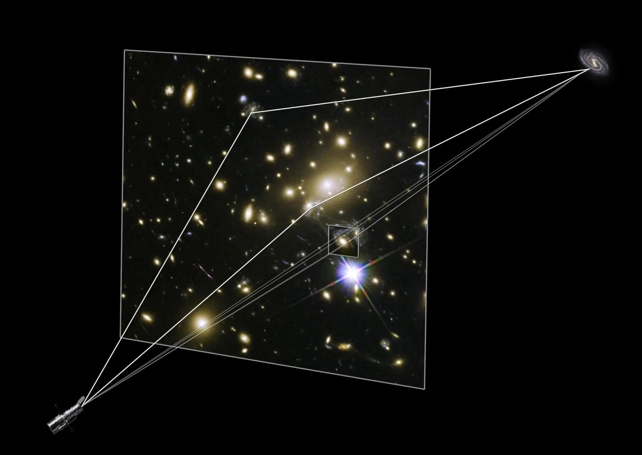It's an exciting time for the fields of astronomy, astrophysics, and cosmology. Thanks to cutting-edge observatories, instruments, and new techniques, scientists are getting closer to experimentally verifying theories that remain largely untested.
These theories address some of the most pressing questions scientists have about the Universe and the physical laws governing it – like the nature of gravity, Dark Matter, and Dark Energy. For decades, scientists have postulated that either there is additional physics at work or that our predominant cosmological model needs to be revised.
While the investigation into the existence and nature of Dark Matter and Dark Energy is ongoing, there are also attempts to resolve these mysteries with the possible existence of new physics.
In a recent paper, a team of NASA researchers proposed how spacecraft could search for evidence of additional physics within our Solar System. This search, they argue, would be assisted by the spacecraft flying in a tetrahedral formation and using interferometers. Such a mission could help resolve a cosmological mystery that has eluded scientists for over half a century.
The proposal is the work of Slava G. Turyshev, an adjunct professor of physics and astronomy at the University of California Los Angeles (UCLA) and research scientist with NASA's Jet Propulsion Laboratory.
He was joined by Sheng-wey Chiow, an experimental physicist at NASA JPL, and Nan Yu, an adjunct professor at the University of South Carolina and a senior research scientist at NASA JPL. Their research paper recently appeared online and has been accepted for publication in Physical Review D.
Turyshev's experience includes being a Gravity Recovery And Interior Laboratory (GRAIL) mission science team member. In previous work, Turyshev and his colleagues have investigated how a mission to the Sun's solar gravitational lens (SGL) could revolutionize astronomy.
The concept paper was awarded a Phase III grant in 2020 by NASA's Innovative Advanced Concepts (NIAC) program. In a previous study, he and SETI astronomer Claudio Maccone also considered how advanced civilizations could use SGLs to transmit power from one solar system to the next.
To summarize, gravitational lensing is a phenomenon where gravitational fields alter the curvature of spacetime in their vicinity. This effect was originally predicted by Einstein in 1916 and was used by Arthur Eddington in 1919 to confirm his General Relativity (GR).

However, between the 1960s and 1990s, observations of the rotational curves of galaxies and the expansion of the Universe gave rise to new theories regarding the nature of gravity over larger cosmic scales. On the one hand, scientists postulated the existence of Dark Matter and Dark Energy to reconcile their observations with GR.
On the other hand, scientists have advanced alternate theories of gravity (such as Modified Newtonian Dynamics (MOND), Modified Gravity (MOG), etc.). Meanwhile, others have suggested there may be additional physics in the cosmos that we are not yet aware of. As Turyshev told Universe Today via email:
"We are eager to explore questions surrounding the mysteries of dark energy and dark matter. Despite their discovery in the last century, their underlying causes remain elusive. Should these 'anomalies' stem from new physics—phenomena yet to be observed in ground-based laboratories or particle accelerators—it's possible that this novel force could manifest on a solar system scale."
For their latest study, Turyshev and his colleagues investigated how a series of spacecraft flying in a tetrahedral formation could investigate the Sun's gravitational field.
These investigations, said Turyshev, would search for deviations from the predictions of general relativity at the Solar System scale, something that has not been possible to date:
"These deviations are hypothesized to manifest as nonzero elements in the gravity gradient tensor (GGT), fundamentally akin to a solution of the Poisson equation.
Due to their minuscule nature, detecting these deviations demands precision far surpassing current capabilities—by at least five orders of magnitude. At such a heightened level of accuracy, numerous well-known effects will introduce significant noise.
The strategy involves conducting differential measurements to negate the impact of known forces, thereby revealing the subtle, yet nonzero, contributions to the GGT."
The mission, said Turyshev, would employ local measurement techniques that rely on a series of interferometers. This includes interferometric laser ranging, a technique demonstrated by the Gravity Recovery and Climate Experiment Follow-On (GRACE-FO) mission, a spacecraft pair that relies on laser range finding to track Earth's oceans, glaciers, rivers, and surface water.
The same technique will also be used to investigate gravitational waves by the proposed space-based Laser Interferometry Space Antenna (LISA).
The spacecraft will also be equipped with atom interferometers, which use the wave character of atoms to measure the difference in phase between atomic matter waves along different paths. This technique will allow the spacecraft to detect the presence of non-gravitational noise (thruster activity, solar radiation pressure, thermal recoil forces, etc.) and negate them to the necessary degree.
Meanwhile, flying in a tetrahedral formation will optimize the spacecrafts' ability to compare measurements.
"Laser ranging will offer us highly accurate data on the distances and relative velocities between spacecraft," said Turyshev.
"Furthermore, its exceptional precision will allow us to measure the rotation of a tetrahedron formation relative to an inertial reference frame (via Sagnac observables), a task unachievable by any other means. Consequently, this will establish a tetrahedral formation leveraging a suite of local measurements."
Ultimately, this mission will test GR on the smallest of scales, which has been sorely lacking to date. While scientists continue to probe the effect of gravitational fields on spacetime, these have been largely confined to using galaxies and galaxy clusters as lenses.
Other instances include observations of compact objects (like white dwarf stars) and supermassive black holes (SMBH) like Sagittarius A* – which resides at the center of the Milky Way.
"We aim to enhance the precision of testing GR and alternative gravitational theories by more than five orders of magnitude.
Beyond this primary objective, our mission has additional scientific goals, which we will detail in our subsequent paper. These include testing GR and other gravitational theories, detecting gravitational waves in the micro-Hertz range—a spectrum not reachable by existing or envisioned instruments— and exploring aspects of the solar system, such as the hypothetical Planet 9, among other endeavors."
This article was originally published by Universe Today. Read the original article.
